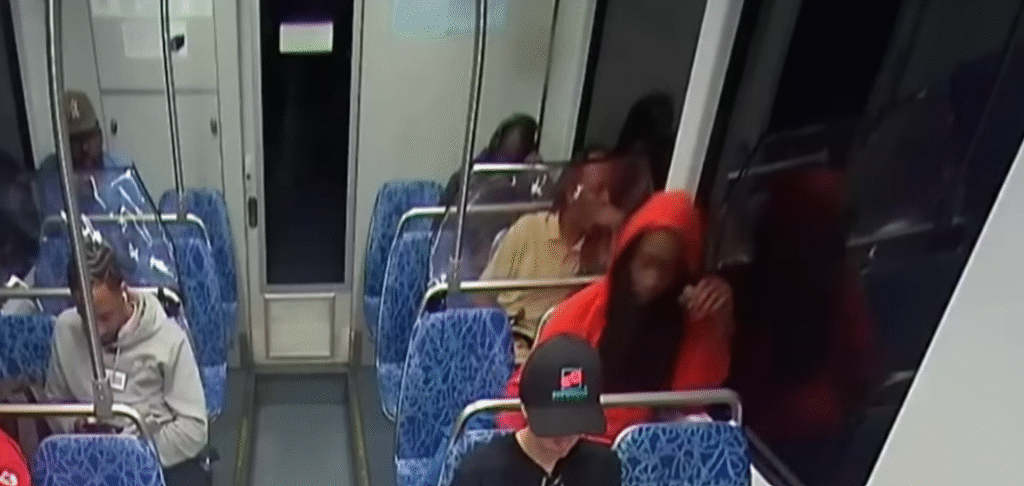Iryna Zarytska: Who was she? She was just 23 years old and represented tenacity, hope, and the unwavering determination to reconstruct a life destroyed by conflict. Her family fled the Russian invasion of Kyiv in 2022, leaving behind only bravery, an ambitious heart, and the will to create something enduring. She quickly adjusted to Charlotte, picking up a job at a pizzeria, going to community college, and pursuing her dream of becoming a veterinary assistant. Described by friends and colleagues as kind, imaginative, and remarkably giving, her absence felt unbelievably heavy following the night of August 22.
She quickly texted her boyfriend that she would be returning home shortly before boarding a light rail train that summer evening. The next horrific event was that a man with a violent past and an untreated mental illness attacked her and fatally stabbed her. Decarlos Brown, 34, the suspect, was taken into custody shortly after the incident, but it left Charlotte inconsolable and provoked a heated national discussion about accountability, safety, and justice.
Because of the extraordinary political attention her story received, leaders from all levels voiced their opinions. Elon Musk attacked legal systems for letting repeat offenders “roam free,” while former President Donald Trump called the attacker a “madman” and even called for the death penalty. Vi Lyles, the mayor of Charlotte, acknowledged systemic shortcomings and promised changes, while Josh Stein, the governor of North Carolina, demanded more transit officers. The surge in national discourse was strikingly similar to how Jordan Neely’s death in New York had sparked discussions about social services and policing in the past. Even so, Iryna’s case was particularly significant because she was a young refugee who had already escaped bomb shelters in Ukraine and was now experiencing violence in the city where she now lived.
Bio Data and Personal Information of Iryna Zarytska
| Category | Details |
|---|---|
| Full Name | Iryna Zarytska (Ірина Заруцька) |
| Date of Birth | 2002 (Age 23 at time of death) |
| Place of Birth | Kyiv, Ukraine |
| Nationality | Ukrainian |
| Status | Refugee, relocated to U.S. in 2022 after Russia’s invasion |
| Residence | Charlotte, North Carolina, United States |
| Education | Graduate of Synergy College, Kyiv (Art and Restoration); attended Rowan-Cabarrus Community College, NC |
| Occupation | Artist, designer, pizzeria employee, aspiring veterinary assistant |
| Languages | Ukrainian, English (learning) |
| Interests | Art, sculpting, fashion design, animal care |
| Date of Death | August 22, 2025 |
| Place of Death | East/West Boulevard Station, Lynx Blue Line, Charlotte, NC |
| Cause of Death | Fatal stabbing |
| Assailant | Decarlos Brown Jr., 34, charged with first-degree murder and federal crime |
| Link | CNN Coverage on Iryna Zarytska |

She is the glue that keeps the family together, according to family members. She had moved to the United States and lived with her uncle and aunt, providing for her mother during the trauma of displacement and showing great affection for her siblings. She had worked briefly at an assisted living facility, where her kindness left a lasting impression, and hundreds of people attended her funeral. Her coworkers at Zepeddie’s Pizzeria described her as more than just a coworker; they also described her as a friend, confidante, and daily source of happiness.
The dreams she had for herself were modest but incredibly motivating. She had recently bought her first car, which she proudly shared with her uncle, was saving money, and was learning to drive. She was getting ready to get her driver’s license, and she intended to visit her family on her first trip. An eerie reminder of a life cut short, this straightforward plan was full of anticipation.
Remarkably, her murder has turned into a prism through which larger concerns in America regarding justice and safety are being analyzed. Officials swiftly announced increased patrols, ticket validators, and obvious security measures in response to criticism of Charlotte’s transit system. The tragedy, which echoed decades of family concerns, reignited national discussions about repeat offenders and the structural deficiencies in mental health care. According to Brown’s sister, a symptom of his untreated schizophrenia was his belief that others could read his thoughts. Their mother had tried, but been rejected, to get him placed in long-term care. He was able to board Iryna’s train because of that failure.
Her story struck a deep chord on a global level. Reports from Ukrainian media expressed deep sadness over the tragedy, portraying it as a double injustice: fleeing one conflict only to die overseas. The case sparked intense discussions about crime rates in the US, according to coverage of the case in the UK by The Telegraph and The Times. Her name, similar to that of Kitty Genovese decades before, came to represent the more significant issues society faces regarding systemic change, public safety, and collective responsibility.
What is especially crucial, though, is to remember Iryna as she really was. She was more than just the news stories, the arguments, and a political talking point. She was a young lady who created eclectic clothing, a neighbor who walked dogs with affection, a friend who was always a source of warmth, and an artist who freely shared her creations. As someone who was resolute to contribute, adapt, and build, rather than as a victim, she personified the spirit of refugees.
Everyone could have died, according to her family. And that reality carries with it very clear lessons: public transportation safety, appropriate care for people with severe mental illness, and justice system accountability are not just theoretical policy issues; they are life-or-death issues. Even though her story has been politicized, her memory ought to spur change and serve as a reminder of the incredibly high human cost of inaction.

